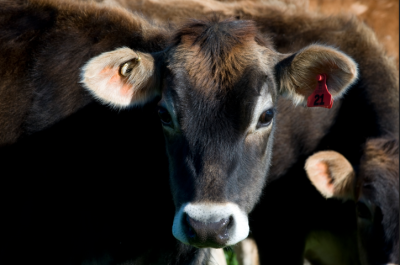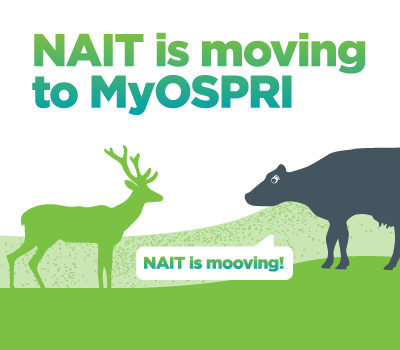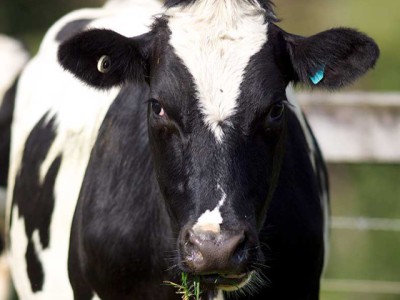 Buying or selling calves? Be a mate, update NAIT
Buying or selling calves? Be a mate, update NAIT
With calf sales starting to pick up, it’s important to make sure that they’re done right. Whether you’re buying or selling calves, here’s what you need to know to meet your NAIT obligations and play your part in supporting lifetime traceability.
Important NAIT basics to remember
When you buy or sell calves, your NAIT and TBfree obligations remain the same. As a reminder, make sure to:
- fit all calves with a NAIT tag before they reach 180 days old or before their first movement off-farm, whichever comes first (the tag should preferably be in the central or inner part of the right ear, between the two veins
- register any fitted NAIT tags within 7 days of tagging or before first movement off farm, whichever comes first
- we recommend using a tag scanner to make registering your animals and recording your movements easier.
 Support for farmers affected by Cyclone Gabrielle in the North Island
Support for farmers affected by Cyclone Gabrielle in the North Island
We have extended the timeframes for updating NAIT to help ease some of the pressure on farmers and other People in Charge of Animals (PICAs) in the following areas:
- Northland Region
- Auckland Region
- Tairāwhiti Region
- Hawke’s Bay Region
- Tararua District
- Thames-Coromandel District
The updated timeframes will apply until the 7th of April 2023.
Support for farmers in Hawke's Bay
In light of extraordinary circumstances of Cyclone Gabrielle, farmers in the Hawke’s Bay are able to apply for a permit to move stock out of the affected MCA (movement controlled area) without pre-movement testing. This is to acknowledge the logistical challenges created by the recent storm.
Animals that move without a pre-movement test will require post-movement testing in most cases. Permits can be requested by phoning 0800 482 463 and providing details of the movement (number of stock and intended destination).
Where animals are received without a permit or pre-movement test due to communication blackout or in case of an emergency, permits may be issued retrospectively. This will require you or the farmer to call OSPRI on 0800 482 463 as soon as practical with the details of the movement. OSPRI will assess the timing, testing requirements and follow up with the relevant farmers.
Farmers can use the link below to identify whether they are in an MCA.
 NAIT is moving to MyOSPRI
NAIT is moving to MyOSPRI
MyOSPRI is an online portal or 'gateway' that will give you access to OSPRI’s new integrated animal disease and traceability system.
NAIT users will need to start using NAIT in MyOSPRI later. The current NAIT system will be turned off.
Once we have transitioned key NAIT features into MyOSPRI, we will start bringing disease information across. When work is complete, you will be able to view disease information and manage livestock movements easily online, and in one place.
Why NAIT in MyOSPRI?
Improving the NAIT system will decrease the barriers farmers currently experience when trying to complete NAIT obligations. When using NAIT in MyOSPRI, farmers will find completing NAIT tasks easier as the system is set up to guide a user through the process.
Complete Animal Status Declarations in MyOSPRI
MyOSPRI has already replaced the electronic ASD system and customers are loving it. You can sign up and start using MyOSPRI now to complete farm to farm and farm to meat processor ASDs now.
 Reductions in Movement Control Areas - a step in the right direction
Reductions in Movement Control Areas - a step in the right direction
In the upper South Island and West Coast, Movement Control Areas (MCA) have been reduced, which is good news for farmers in the area, says OSPRI.
As of 1 March 2023, the reduced areas include a portion of North Canterbury (to the south of Kaikoura) and significant portions of the West Coast (approximately 1 million hectares) affecting herds from south of Hokitika to the Paparoa Range. This change will result in 683 herds no longer requiring pre-movement testing, or animals to be tested down to 3 months of age.
When making the decision to revoke part or all of the Movement Control Area, we calculate the prevalence of disease in herds each year over a three-year period to make sure it consistently falls below the 1% threshold, says OSPRI’s Senior Veterinarian Kevin Crews. “This requirement is coupled with the risk assessment work that vets do to ensure that any wildlife in the area that was spreading TB to livestock is absolutely under control. In other words, we have done a thorough investigation spanning a three-year period to make sure that the prevalence of disease in herds is less than 1% each year. In the past three years, we did 144,418 pre-movement tests on the West Coast in the affected area, and there have been no infected herds found during that period, from pre-movement testing, or post-movement testing.”

